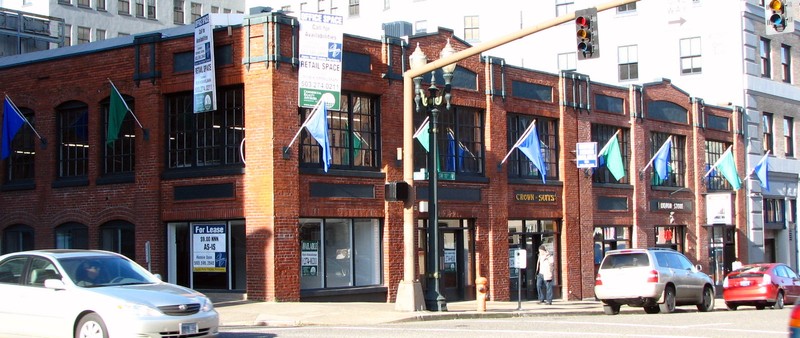The Auto Rest Garage
Introduction
Text-to-speech Audio
Images
Exterior view of the Auto Rest Garage today (Wikimedia commons)

Backstory and Context
Text-to-speech Audio
The automobile industry grew rapidly in Portland during the early years of the 20th century, as elsewhere in the country ownership of vehicles grew from one hundred and eighty thousand to more than four million. By the 1920s, those living in the suburban neighborhoods of the city were becoming increasingly affluent and in demand of vehicles. The Auto Rest Garage was founded in 1917 to serve as a showroom and sales space for C. D. McPhail, and employee of Stutz and Columbia Six Automobiles. The company was managed by Harry C. Stutz, a self-taught engineer and car manufacturer born in Dayton, Ohio, in the late 19th century.
The company chose an irregularly-shaped plot of land at the commercial core of the city, between 10th and Salmond Streets, and commissioned Joseph Jacobberger to design and build it. The complex consists of two almost-identical Commercial-style structures occupying a total area of about one hundred by ninety feet; each is two-storied, with a simple bow-truss roof, sharing a similar floor plan, and are both built of heavy timber framing and red brick masonry laid in a common American bond pattern. The primary access point was via 10th Avenue, as indicated by the remarkable eastern façade of the building. Twin sets of three bays are divided by brick strip pilasters climbing the entire height of the building, each capped with a carved decorative triangular pediment. The second story is brightly illuminated by a sequence of twelve large mullioned windows. At the base of each of these bays was a sliding door, through which vehicles could be granted access to the building. Inside, access to the second story was achieved from the northern part of the building via a car ramp installed in 1930 – though this has since been demolished.
At the time, this neighborhood was occupied by dozens of automobile services, including William Knighton's Packard building on NW 23rd Avenue. Nonetheless, the Columbia Six automobile was quite popular. It was easily assembled, but was considered extremely desirable for its cheap price and high quality interiors, embellished with walnut dashboards, beveled windows and hassock. Eventually, however, the invention of the Model T by Henry Ford forced the Auto Rest Garage to go bust as a show- and sales-room. By the mid-1920s Ford motorcars accounted for more than half of all automobile sales in the country.
Major alterations were then made to the structure. From the mid-1930s it served as the garage for the nearby Medical Arts Building. In 1962 parts of the building were converted into offices used by Jaggar Sroufe Co. In 1987 the ground floor began being divided into commercial spaces, and the vehicular ramp to the second floor was removed the following year. By 1991 almost the entire ground floor had been converted into use as retail space, though the second story is still used for parking to this day. Today almost all of the historic features inside the building have disappeared, though the exterior is very well preserve. Furthermore, it serves as a fine point of departure to visit the surrounding attractions, including the Medical Arts Building, the Multnomah County Library, the Winters Apartment, the Bates Motoramp, the Odd Fellows Building and Masonic Temple.
